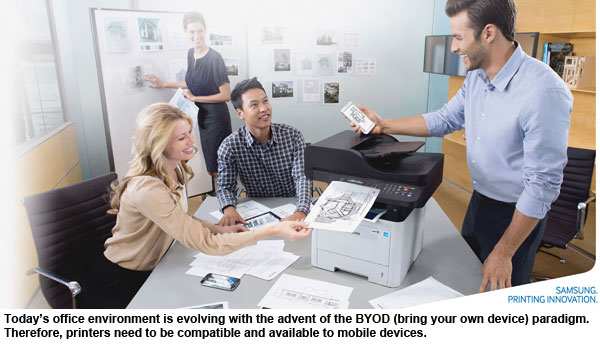Samsung flexes muscle in B2B printing solutions
MANILA, Philippines - Suwon City, Seoul, South Korea — The world is familiar with Samsung as a leader in electronics, and remains at the forefront of pushing the digital envelope. The truth of the matter is that the biggest South Korean conglomerate (or chaebol in local parlance) has both size and breadth in “businesses that span advanced technology, semiconductors, skyscraper and plant construction, petrochemical, fashion, medicine, finance, hotels and more.â€
For good reason, Samsung is known particularly for consumer products — technological feats that end up in the hands of a growing legion of customers. According to third-party business authorities, Samsung ranks first among most sustainable technology companies. It is the second most innovative company, the second biggest US patent winner, and eighth-best global brand.
The so-named Samsung Digital City here is a compelling testament to the strength and vigor of the group of companies. Occupying a total of 1.41 million square meters (equivalent to 205 soccer fields) are three complexes housing 131 buildings — where some 35,000 employees go to work. It is a truly self-contained ecosystem with 23 sports facilities, 14 dining centers, four parks, and even hospitals, shopping malls and swimming pools.
The company is not done, either, and openly harps about its 2020 vision (forged in 2009) to grow revenues to a hefty $400 billion from $189 billion in 2012.
Bigger B2B slice from evolving office
Curiously, Samsung is expecting the most growth not from retail but from its B2B (business-to-business) portfolio, which is envisioned to comprise a bigger share in revenue generation from six percent in 2012 to 21 percent or $84 billion in 2020.
Samsung Electronics Printing Solutions VP Hyesung Ha reveals to an Asia-Pacific delegation of media here that Samsung had unified its printing and PC business units in 2009 as an IT solutions unit. “Last year, we made printing independent again,†she says.
This obviously is in anticipation of, and an earnest push toward, growth in the printer business — piggybacked on the evolution of the workplace and its evolving demands.
“In today’s office environment, traditional client-server systems are no longer in existence. Work processes are not combined to a location or within a building,†Ha continues. “Customers are working with more mobility than ever before, and because of these changes, Samsung has prepared a new printing ecosystem that would meet these changes. The way we are positioning our new business unit is that we will transform printing for the new office environment.â€
The new paradigm is seeing the advent of the BYOD (bring your own device) phenomenon in the workplace. Ha cites a study that 89 percent of employees’ mobile devices are connected to corporate networks. Telecommuting or remote working arrangements are more commonplace. Shunning the office, or rather, opening its four walls is even showing up in the fact that there are now presently only seven desks for every 10 employees.
Increased demand to fuel segment growth
Increased mobility has also meant increased demand for mobile printing. In 2011, the figure was at 16 percent; the 2015 rate is expected to be at 49 percent. Samsung Printing Solutions thus continue to be exponentially crucial.
“Among the B2B markets in all the devices and categories that we serve in Samsung Electronics, the printers market is the biggest. In fact, 85 percent of the market is B2B in printing,†Ha says.
Underscoring the segment’s key importance, perhaps, is the fact that Samsung brass has appointed David Song, a Samsung veteran of almost 30 years, to head the business group. Song, a senior vice president, shares that Samsung has been known for “products that have become industry standards.â€
He expects the firm to continue serving up the same kind of innovative products for the B2B segment in the printer market.
Self-contained innovation
While admitting that Samsung is a relatively new player in a business that has had no new entrants in the last 30 years, its officials insist that its products have not had to play catch-up to its competitors.
This is because Samsung has had the luxury of convergence and synergy — leveraging on its long history of the independently developing and manufacturing semiconductors. Ha says Samsung thus has the advantage of “fully vertically integrated, end-to-end capabilities,†which eliminates the need for jobbing out other components to third parties. The result is truly Samsung-dedicated components — made for Samsung, by Samsung — such as CPU, memory, scanning, and imaging units.
The conglomerate even has its own world-class comprehensive EMC (electromagnetic compatibility) test facilities to run its products through a gauntlet of some 20 tests for adherence to standards in terms of emissions and interference. The media group is later able to tour the huge, multi-lab facility — the biggest testing room which measures 26 by 18 meters and is 11 meters high.
Four core values
As its printing business segment becomes an engine for what Ha calls Samsung’s fourth wave of growth (the previous three being the memory chip in the ‘90s, the flat-panel TV in 2006, and the smartphone in 2013), Samsung crystallizes its printing DNA into four core values where it distinguishes itself from the competition: speed, eco (mustering up to 20 percent in toner savings while enabling prudent paper consumption), quality (cleaner rendering of pages), and mobility (“tap to print†feature, Wi-Fi Direct and NFC support, etc.).
Its mobility value obviously leverages mobile capability from key Samsung devices (i.e., smartphones) for a more seamless workflow to and from the printer.
Samsung also touts itself to be the only company in this segment to satisfy the four pillars of the B2B printing business, with a range of products for the SOHO (small office/home office), small business, medium business, and large enterprises.
The message is clear, insists Ha: “We were a very B2C-centric before. We are going to be a balanced B2B-oriented company by 2020.â€
Offices of every size and shape should take heed.
- Latest






























